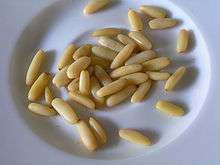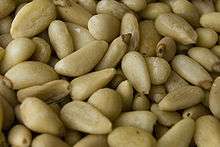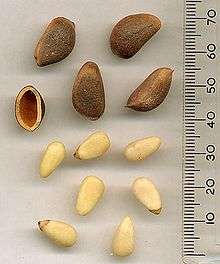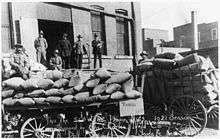Pine nut



Pine nuts are the edible seeds of pines (family Pinaceae, genus Pinus). About 20 species of pine produce seeds large enough to be worth harvesting; in other pines the seeds are also edible, but are too small to be of notable value as a human food.[1][2][3]
Species and geographic spread
In Asia two species are widely harvested, Korean pine (Pinus koraiensis) in northeast Asia (the most important species in international trade), and chilgoza pine (Pinus gerardiana) in the western Himalaya. Four other species, Siberian pine (Pinus sibirica), Siberian dwarf pine (Pinus pumila), Chinese white pine (Pinus armandii) and lacebark pine (Pinus bungeana), are also used to a lesser extent. Afghanistan is an important source of pine nuts.
Pine nuts produced in Europe mostly come from the stone pine (Pinus pinea), which has been cultivated for its nuts for over 5,000 years, and harvested from wild trees for far longer. The Swiss pine (Pinus cembra) is also used to a very small extent.
In North America, the main species are three of the pinyon pines: Colorado pinyon (Pinus edulis), single-leaf pinyon (Pinus monophylla), and Mexican pinyon (Pinus cembroides). The other eight pinyon species are used to a small extent, as are gray pine (Pinus sabineana), Coulter pine (Pinus coulteri), Torrey pine (Pinus torreyana), sugar pine (Pinus lambertiana) and Parry pinyon (Pinus quadrifolia). "Pinyon" is spelled as piñon in Spanish.
In the United States, pine nuts are mainly harvested by Native Americans, particularly the Uto-Aztecan: Shoshone, Paiute Navajo [Dine], and Hopi, and Washoe tribes.[4] Certain treaties negotiated by tribes and laws in Nevada guarantee Native Americans' right to harvest pine nuts.[5]
The Pinus monophylla seeds, commonly known as the Nevada Soft Shell Pine Nut, are harvested by commercial harvesters in Nevada, and sold throughout the western US.[6]
Species list
For those seeking to grow edible landscapes, these are the more commonly used species.
- Old World
- Pinus pinea - Italian stone pine
- Pinus cembra - Swiss pine
- Pinus koraiensis - Korean pine
- Pinus gerardiana - Chilgoza pine
- Pinus sibirica - Siberian pine
- Pinus pumila - Siberian dwarf pine
- Pinus armandii - Chinese white pine [reputed to cause "taste disturbance"]
- Pinus bungeana - lacebark pine
- New World
- Pinus cembroides – Mexican pinyon
- Pinus orizabensis – Orizaba pinyon
- Pinus johannis – Johann's pinyon (includes P. discolor – Border pinyon)
- Pinus culminicola – Potosi pinyon
- Pinus remota – Texas pinyon or papershell pinyon
- Pinus edulis – Two-needle pinyon or Colorado pinyon
- Pinus monophylla – Single-leaf pinyon
- Pinus quadrifolia – Parry pinyon
Pollination and seed development
The pine nut (seed) species will take a time that depends on the exact species (e.g. 36 months for a stone pine seed) to complete its maturity; to reach full maturity, the environmental conditions must be favorable for the tree and its cone.
For some American species development begins in early spring with pollination. A tiny cone, about the size of a small marble, will form from mid-spring to the end of summer; the premature cone will then become and remain dormant (with a cessation of growth) until the following spring. The cone will then commence growth until it reaches maturity near the end of summer.[7] The mature piñon pine cone is ready to harvest ten days before the green cone begins to open. A cone is harvested by placing it in a burlap bag and exposing it to a heat source such as the sun to begin the drying process. It takes about 20 days until the cone fully opens. Once it is fully open and dry, the seed can be easily extracted in various ways. The most common and practical extraction method used is the repeated striking of the burlap bag containing the cone(s) against a rough surface to cause the cone(s) to shatter, leaving just the job of separating by hand the seed from the residue within the bag.
Another option for harvesting is to wait until the cone opens on the tree (as it naturally will) and harvest the cone from the piñon pine, followed by the extracting process mentioned above. Fallen seed can also be gathered beneath the trees.[8]
Ecology and status
In the United States, millions of hectares of productive pinyon pine woods have been destroyed due to conversion of lands, and in China, destructive harvesting techniques (such as breaking off whole branches to harvest the cones) and the removal of trees for timber have led to losses in production capacity.[2]
Elevation and pinecone production


The elevation of the pinyon pine is an important determinant of the quantity of pine cone production, and therefore, will largely determine the amount of pine nuts the tree will yield.[9]
American Pinyon pine cone production is most commonly found at an elevation between 6,000 feet (1,800 m) and 8,500 feet (2,600 m), and ideally at 7,000 feet (2,100 m). This is due to higher temperatures at elevations lower than 6,000 feet (1,800 m) during the spring, which dry up humidity and moisture content (particularly snow packs) that provide for the tree throughout the spring and summer, causing little nourishment for pine cone maturity.
Although there are several other environmental factors that determine the conditions of the eco-system (such as clouds and rain), without sufficient water the trees tend to abort cones. High humidity encourages cone development. There are certain topographical areas found in lower elevations, such as shaded canyons, where the humidity remains constant throughout the spring and summer, allowing pine cones to fully mature and produce seed.
At elevations above 8,500 feet (2,600 m), the temperature substantially drops, drastically affecting the state of the dormant cone. During the winter, frequent dramatic changes in temperature, along with drying, gusty winds, make the cones susceptible to freeze-drying that damages them permanently; in this case, growth is stunted and the seeds wither away.[10]
Physical characteristics

Pine nuts contain 10–34% protein depending on species, with stone pine having the highest content.[2] They are also a source of dietary fiber. When first extracted from the pine cone, they are covered with a hard shell (seed coat), thin in some species, thick in others. The nutrition is stored in the embryo (sporophyte) in the centre. Although a nut in the culinary sense, in the botanical sense pine nuts are seeds; being a gymnosperm, they lack a carpel (fruit) outside.
The shell must be removed before the pine nut can be eaten. Unshelled pine nuts have a long shelf life if kept dry and refrigerated (−5 °C (23 °F) to 2 °C (36 °F)); shelled nuts (and unshelled nuts in warm conditions) deteriorate rapidly, becoming rancid within a few weeks or even days in warm humid conditions. Pine nuts are commercially available in shelled form, but due to poor storage, can have poor flavor and may be already rancid at the time of purchase. Consequently, pine nuts are often frozen to preserve their flavor.
European pine nuts may be distinguished from Asian ones by their greater length in comparison to girth; Asian pine nuts are stubbier, shaped somewhat like long kernels of corn. The American piñon nuts are known for their large size and ease of shelling. In the United States, P. edulis, the hard shell of New Mexico and Colorado, became a sought-after species due to the trading post system, and the Navajo people who used the nuts as a means of commerce. The Italian pine nut (P. pinea) was brought to the United States by immigrants, and became a favored treat along the East Coast in the early 1930s, when bumper crops of American pine nuts were readily available at low prices.
Culinary uses
| Nutritional value per 100 g (3.5 oz) | |
|---|---|
| Energy | 2,815 kJ (673 kcal) |
|
13.1 g | |
| Starch | 1.4 g |
| Sugars | 3.6 g |
| Dietary fiber | 3.7 g |
|
68.4 g | |
| Saturated | 4.9 g |
| Monounsaturated | 18.7 g |
| Polyunsaturated | 34.1 g |
|
13.7 g | |
| Vitamins | |
| Vitamin A equiv. |
(0%) 1 μg (0%) 17 μg |
| Thiamine (B1) |
(35%) 0.4 mg |
| Riboflavin (B2) |
(17%) 0.2 mg |
| Niacin (B3) |
(29%) 4.4 mg |
|
(6%) 0.3 mg | |
| Vitamin B6 |
(8%) 0.1 mg |
| Folate (B9) |
(9%) 34 μg |
| Choline |
(11%) 55.8 mg |
| Vitamin C |
(1%) 0.8 mg |
| Vitamin E |
(62%) 9.3 mg |
| Vitamin K |
(51%) 53.9 μg |
| Minerals | |
| Calcium |
(2%) 16 mg |
| Iron |
(42%) 5.5 mg |
| Magnesium |
(71%) 251 mg |
| Manganese |
(419%) 8.8 mg |
| Phosphorus |
(82%) 575 mg |
| Potassium |
(13%) 597 mg |
| Zinc |
(67%) 6.4 mg |
| Other constituents | |
| Water | 2.3 g |
| |
|
Percentages are roughly approximated using US recommendations for adults. Source: USDA Nutrient Database | |
Pine nuts have been eaten in Europe and Asia since the Paleolithic period. They are frequently added to meat, fish, salads and vegetable dishes or baked into bread.
In Italian they are called pinoli (in the US they are often called pignoli, but in Italy pignolo is actually a word far more commonly used to describe a fussy, overly fastidious or extremely meticulous person)[11] and are an essential component of Italian pesto sauce; the upsurge in the popularity of this sauce since the 1990s has increased the visibility of the nut in America, primarily on the West Coast. Torta della nonna (literally "granny's cake") is quite a generic Italian dish name that while in most families just indicates an old family recipe for any kind of cake, very often is used for a tart or a pie filled with custard, topped with pine nuts and optionally dusted with icing sugar. Pignoli cookies, an Italian American specialty confection (in Italy these would be called biscotti ai pinoli), are made of almond flour formed into a dough similar to that of a macaroon and then topped with pine nuts.
In Catalonia, a sweet is made of small marzipan balls covered with pine nuts, painted with egg and lightly cooked, and those are called "Panellets". Pine nuts are also featured in the salade landaise of southwestern France. The Nevada, or Great Basin, pine nut has a sweet fruity flavor and is promoted for its large size, sweet flavor and ease of peeling. Pine nuts are also widely used in Middle Eastern cuisine, reflected in a diverse range of dishes such as kibbeh, sambusak, desserts such as baklava, and many others.
Throughout Europe and Middle East the pine nuts used are traditionally from Pinus pinea (stone pine). They are easily distinguished from the Asian pine nuts by their more slender shape and more homogeneous flesh. Due to the lower price, Asian pine nuts are also often used, especially in cheaper preparations. Pine nuts contain thiamine (vitamin B1) and protein.
Pine nut coffee, known as piñón (Spanish for pine nut), is a specialty found in the southwest United States, especially New Mexico, and is typically a dark roast coffee having a deep, nutty flavor; roasted and lightly salted pine nuts can often be found sold on the side of the road in cities across New Mexico to be used for this purpose, as well as a snack.
Taste disturbances
Pine nuts can cause taste disturbances, lasting from a few days to a few weeks after consumption. A bitter, metallic, unpleasant taste is reported. There are no known lasting effects, with the FDA reporting that there are "no apparent adverse clinical side effects."[12] This phenomenon was first described in a scientific paper in 2001.[13] Publications have made reference to this phenomenon as "pine nut syndrome" (PNS), or as "pine mouth."[14]
The Nestlé Research Centre has hypothesized that nuts from Pinus armandii, which occurs mostly in China, are the cause of the problem. The nuts of this species are smaller, duller, and more rounded than typical pine nuts.[15] A 2011 study found results consistent with this hypothesis, and also suggested that chemicals used in the shelling process might be responsible.[16]
Metallic taste disturbance, known as metallogeusia, is typically reported 1–3 days after ingestion, being worse on day two and typically lasting up to two weeks. Cases are self-limited and resolve without treatment.[17][18] Möller has postulated a hypothesis—to explain both the delayed onset of, and the long-lasting nature of, the metallic or bitter taste sensation—involving a well-known physiological process known as enterohepatic recirculation (EHR), which Möller describes as a "remove-recycle-repeat" digestive process where toxins could potentially circulate through the digestive tract multiple times.[19]
Nutritional information
100 grams of dried pine nuts contains:[20]
- Calories: 673
- Carbohydrates: 13.08 g
- Fats: 68.37 g
- Fibers: 3.7 g
- Protein: 13.69 g
- Cholesterol: 0 mg
Pine nut oil
Pine nuts can be pressed to extract pine nut oil, which is valued for its mild, nutty flavor. One study indicates that Korean pine nut oil may suppress appetite.[21]
Other uses
Pine nuts have long been a dietary staple in some Native American tribes. Today, though some tribes still use pine nuts in traditional cooking, others use the hard outer shell of the pine nut as a bead for decorative purposes in traditional regalia and jewelry. In the Great Basin area of the US, collecting pine nuts is a protected right through state law and treaty.[22]
In the northern California regions, pine nuts are collected from the Grey Pine (or Bull Pine.) Tribes burn designs into the hard shell, reflecting the same design they use in baskets, however oftentimes they are left in blank, or burned to blacken. These are more often used in women's regalia and jewelry.[23]
See also
| Wikimedia Commons has media related to Pine nuts. |
References
- ↑ Farjon A (2005). Pines. Drawings and descriptions of the genus Pinus. Koninklijke Brill. ISBN 90-04-13916-8.
- 1 2 3 Lanner RM (1981). The Piñon Pine. A Natural and Cultural History. University of Nevada Press. ISBN 0-87417-066-4.
- ↑ Lanner RM (1981). Made for Each Other. A Symbiosys of Birds and Pines. Oxford University Press. ISBN 0-19-508903-0.
- ↑ "History of Pine Nuts & The People of the Great Basin." Goods from the Woods. 2004 (retrieved 8 Dec 2009)
- ↑ Frazier, Penny. "Pine Nuts, Politics and Public Lands." Raw Foods News Magazine. (retrieved 8 Dec 2009) Archived October 30, 2006 at the Wayback Machine
- ↑ Liston Pine Nuts “What is the Nevada soft shell pine nut” (retrieved 27 November 2014)
- ↑ Pine Nuts, WholeSale. "Pollination and Seed Development to Maturity in 18 months." Pine Nut Information (retrieved 5 Mar 2010)
- ↑ Pine Nuts, WholeSale. "The Mature Fruit and Harvesting Process of Pine Nuts." Pine Nuts Information (retrieved 10 Apr 2010)
- ↑ Pine Nuts, WholeSale. "Elevation and Pinecone Production." Ws Pine Nut News (retrieved 20 Apr 2010)
- ↑ Pine Nuts, WholeSale. "Pinecone production in regards to Elevation." Pinecone Characteristics and Ecology (retrieved 20 Apr 2010)
- ↑ Locally also pinoccoli or pinocchi; Pinocchio is the Tuscan (Florentine) word for "pine nut", from Latin *pīnuculus. (Devoto, Battisti-Alessio)
- ↑ ""Pine Mouth" and Consumption of Pine Nuts". March 14, 2011. Retrieved January 2, 2016.
- ↑ Mostin, M. (2001). "Taste disturbances after pine nut ingestion". European Journal of Emergency Medicine 8: 76. doi:10.1097/00063110-200103000-00036.(Subscription required.)
- ↑ Christopher Middleton (May 2009). "Pine mouth puzzle: Why do these nuts leave you with a bitter taste?". Daily Mail. Retrieved January 2, 2016.
- ↑ "The Great Pine Nut Mystery". June 4, 2011. Retrieved January 2, 2016.
- ↑ Destaillats, Frédéric; Cruz-Hernandez, Cristina; Giuffrida, Francesca; Dionisi, Fabiola; Mostin, Martine; Verstegen, Geert (2011). "Identification of the Botanical Origin of Commercial Pine Nuts Responsible for Dysgeusia by Gas-Liquid Chromatography Analysis of Fatty Acid Profile" (PDF). Journal of Toxicology 2011: 1–7. doi:10.1155/2011/316789. PMC 3090612. PMID 21559093. Retrieved January 2, 2016.
- ↑ Munk, Marc-David (2010). ""Pine Mouth" Syndrome: Cacogeusia Following Ingestion of Pine Nuts (Genus: Pinus). An Emerging Problem?". Journal of Medical Toxicology 6 (2): 158–159. doi:10.1007/s13181-009-0001-1. PMID 20049580. Retrieved January 2, 2016.
- ↑ Ballin, Nicolai Z. (Feb 17, 2014). "A Trial Investigating the Symptoms Related to Pine Nut Syndrome". Journal of Medical Toxicology 8: 278–280. doi:10.1007/s13181-012-0216-4. Retrieved January 2, 2016.
- ↑ Möller, G. (2010). "The Curious Case of the Epicurean Nut". Food Technology Magazine 64 (5). Retrieved January 2, 2016.
- ↑ Show Foods
- ↑ Hughes GM, Boyland EJ, Williams NJ, et al. (2008). "The effect of Korean pine nut oil (PinnoThin™) on food intake, feeding behaviour and appetite: A double-blind placebo-controlled trial". Lipids Health Dis 7: 6. doi:10.1186/1476-511X-7-6. PMC 2289823. PMID 18307772.
- ↑ "Indians 101: Pine Nuts".
- ↑ "Our People, Traditional Materials and Designs - Karuk, Yurok, Hupa".
Further reading
- Farris, Glenn J. (1982). "Pine Nuts as an Aboriginal Food Source in California and Nevada: Some Contrasts". Journal of Ethnobiology 2 (2): 114–122.
- Farris, Glenn J. "Quality Food: The Quest for Pine Nuts in Northern California." In Before the Wilderness: Environmental Management by Native Californians, comp. and ed. T. C. Blackburn, and K. Anderson, 229-240. Ballena Press Anthropological Papers, no. 40. Menlo Park, Calif.: Ballena Press, 1993.
External links
- Dan Charles (2014-10-08). "Love Pine Nuts? Then Protect Pine Forests". Retrieved 2015-04-19.
| ||||||||||||||||||
| |||||||||||||||||||||||||||||||||||||||||||||
